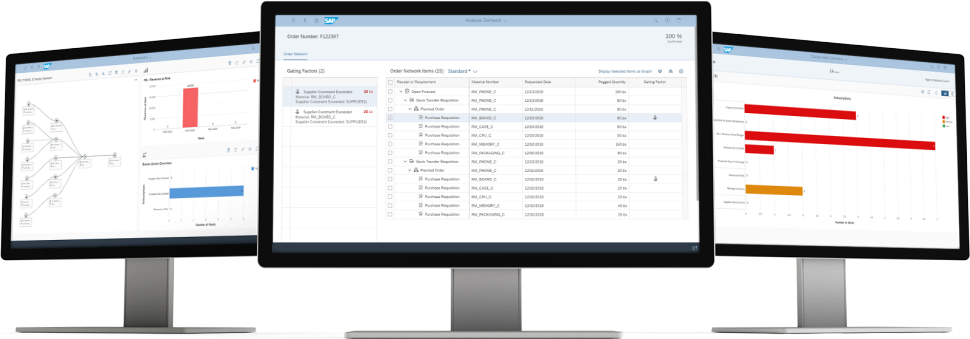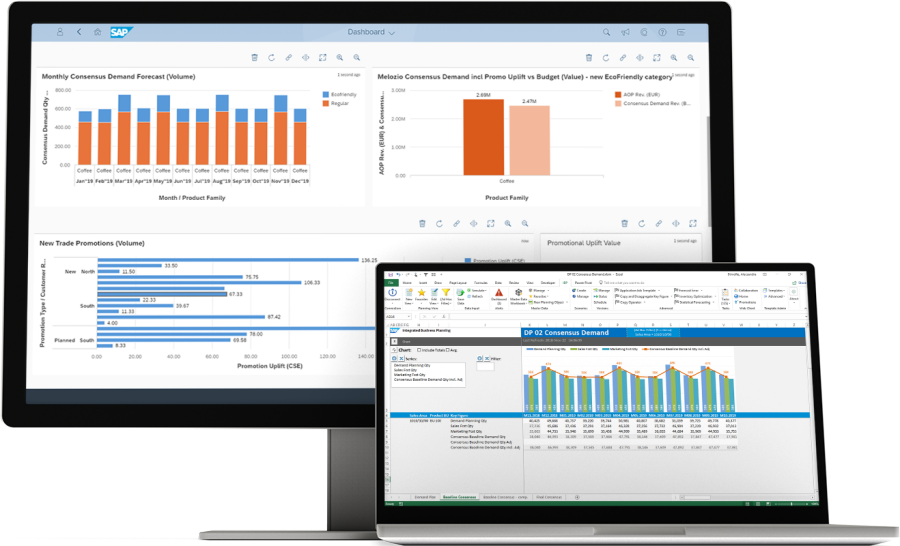SAP Solutions
Integrated Business Planning & Reporting
Integrated Business Planning Software
Respond to new market expectations with real-time supply chain planning capabilities.
SAP Integrated Business Planning for Supply Chain
Meet future demand in a profitable way through real-time supply chain management. Powered by in-memory computing technology within SAP HANA, the SAP Integrated Business Planning for Supply Chain (SAP IBP for Supply Chain) solution supports sales and operations; demand, response, and supply planning, and inventory optimization.
- Cloud deployment
- Real-time scenarios and simulation
- Social collaboration
- Powerful predictive analytics
Key Benefits
Achieve a rapid deployment
Get up and running quickly with SAP Integrated Business Planning with the use of preconfigured process templates for accelerated implementation.
Empower employees with intuitive features
Offer a unified, intuitive user experience with SAP Fiori and planning and simulation capabilities based on Microsoft Excel.
Integration with SAP Supply Chain Control Tower
Integrate with SAP Supply Chain Control Tower and gain end-to-end visibility of your supply chain, decision support, and fast corrective action.
Sales and operations planning
Deliver a cross-departmental sales and operations plan that balances inventory, service levels, and profitability.
Forecasting and demand management
Get full demand transparency with short-term, mid-term, and long-term forecasting. Take advantage of best-in-class capabilities for demand sensing and statistical forecasting.
Response and supply planning
Create supply plans based on prioritized demands, allocations, and supply chain constraints, in order to optimize resourcing efficiency.
Inventory optimization
By establishing optimal inventory targets you are in the position to maximize profits, while unexpected demand can be met by setting up related buffers.
Demand-driven replenishment
Tame supply-chain variability and improve material flow by following techniques for demand-driven material requirements planning (DDMRP).
Advanced Planner and Optimizer (APO)
Three Pillars of APO
- Demand Planning (DP)
- Production Planning and Detailed Scheduling (PP/DS)
- Supply Network Planning (SNP)
Demand Planning (DP)
The Demand Planning Benchmark is one of three benchmarks in the SAP APO Benchmark suite. Demand planning enables supply chain partners to forecast and plan demand in consideration of historical demand data, causal factors, marketing events, market intelligence, and sales objectives. Results from the planning process can be automatically fed to other nodes of the supply chain.
DP Benchmark Description
In the benchmark, mass processing is used allowing you to create demand forecasts for large numbers of products while optimizing system resources. All mass processing jobs run concurrently in the background.
For the Demand Planning Benchmark, the baseline scenario assumes that each of 2,000 customers buys 500 products, resulting in 1 million characteristic combinations (2,000 customers times 500 products). As demand planning considers the last two years to plan for the next two years, the total number of time buckets (measured in weeks) is 208 (corresponding to the 208 weeks of four years). Therefore, the total number of data records considered is 208 million. The number of automatically aggregated characteristic combinations (combinations of products and distribution centers) is 100,000. (Under the condition that all products are available in each distribution center.) The results of the benchmark are demand figures that result in actual demand.
Production Planning and Detailed Scheduling (PP/DS)
The Production Planning and Detailed Scheduling (PP/DS) Benchmark is one of three benchmarks in the SAP APO Benchmark suite. Companies use the component Production Planning and Detailed Scheduling (PP/DS) to plan and optimize multi-site production, while simultaneously taking into account product and capacity availability.
PP/DS Benchmark Description
Based on heuristics the Production Planning Benchmark solves specific planning tasks for selected objects, depending on the focus of planning – for example, products, operations, resources, or line networks – using a particular planning procedure algorithm.
This benchmark creates customer demands in each production plant and uses the production planning run to fulfill them. The benchmark covers two layers:
- Plants that produce materials
- Suppliers to the plants
Supply Network Planning (SNP)
SAP APO integrates purchasing, manufacturing, distribution, and transportation into one consistent model enabling organizations to create a very close match between supply and demand. SAP APO is able to synchronize activities and plan material flow throughout the entire supply chain. The results are feasible plans for purchasing, manufacturing, inventory, and transportation.
SAP APO also enables organizations to dynamically determine how and when inventory should be distributed. The system draws on the data universally available in liveCache to optimize deployment plans based on available algorithms, as well as user rules and policies.
In the benchmark, mass processing is used, allowing you to run the heuristic planning for large numbers of product-location combinations, with mass processing jobs running concurrently in the background.
SNP Benchmark Description
This benchmark covers the demand of the distribution centers (DC) that has been created by the demand planning run. The benchmark covers three layers:
- The DCs that have the demand
- Plants that produce the materials needed
- Suppliers to the plants
For example, a supply network contains 20 suppliers, 10 plants, 10 distribution centers, and 250 transportation lanes. We assume 93 raw products and 10,000 finished products. In total, there are 120,093 location products. Each plant manufactures 2,000 finished products. At each DC, all 10,000 products are available.
Disclosure Management
Introduction to Disclosure Management
SAP’s disclosure management solutions enable customers to go the last mile to ensure a timely, accurate and risk-free financial close process, by managing the production, filing and publication of financial statements and reports.
Benefits:
- Accelerate the financial close while lowering the cost of compliance
- Bring complex financial processes into a single framework
- Provide financial professionals a visual, easy-to-use way to manage financial statement production
- Enable collaboration and workflow between individuals and teams
- Meet the new demands of XBRL publishing and IFRS compliance
- Offers multiple output options for financial statement filing and publication
- Perfect fit with other SAP solutions
SAP Disclosure Management is based on four fundamental concepts:
- Authorization – This concerns the permissions that users have for specific system tasks.
- Workflow – This concerns the steps and phases of the lifecycle of a document and the sequence of the tasks to be performed within those steps.
- Report and Period – This concerns the setup of the document master data.
- Data Cache – This concerns the data availability.
Authorizations
Authorizations in SAP Disclosure Management follow the principle “what is not allowed is forbidden”. They include the following elements:
- Permissions
- Users
- Roles
- Report and chapter
- Entities
Roles and permissions are used in workflows to restrict the execution of activities and, if necessary, step actions to specific roles or authorization objects. The permissions of a given report level are inherited by its lower levels unless these levels’ permissions are explicitly set differently. This helps maintain local permissions.
In addition, you can assign one or several roles to users for one or several entities. Consequently, a user can have different roles in different entities.
An entity gives a user access to group reports, reports of any entity, or reports assigned to particular entities. Users may administer and assign units to which they themselves are assigned. The combination of unit and role defines a user’s access rights.
Workflows
A workflow in SAP Disclosure Management describes the standard lifecycle of a report, which means the phases the report runs through, from the creation of the report structure to the editing of chapters and terminating with the finalization of the consolidated report content. A workflow is a mandatory characteristic of a report and its chapters.
The workflow contains steps to which are assigned step statuses. These step statuses describe the standard lifecycle of a document, from its creation to the editing and finalization of the document.
Reports and Periods
The basic elements in SAP Disclosure Management are periods and reports. A period is a report group that can contain an unlimited number of reports. A consolidated report is a generated file that contains one or more chapters. The settings defined for periods and reports control the behavior and handling of these elements when editing the reports.
The diagram below displays an overview of the relationship between periods, reports, chapters, and specific types, which are configured by the administrator of SAP Disclosure Management.
Data Caches
A data cache in SAP Disclosure Management is both the internal location and an object to store the quantitative data to which the user refers while editing chapters. A data cache object is always an Excel workbook. You can save as many workbooks as required by your cache and report structure. An internal data cache must be used in the following cases:
- When the quantitative data is maintained only manually and there are no external data sources involved.
- When the quantitative data extracted from external data sources need to be manipulated before it is used in reports.
- When the quantitative data extracted from external data sources lack unique identifiers.




